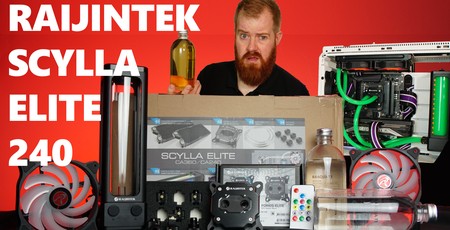
Andy takes an in-depth look at the Raijintek Scylla Elite 240 watercooling kit. Key time stamps are as follows:
01:25 - Unboxing and Overview
13:29 - Benchmarks
16:30 - Analysis
25:22 - Conclusion
CPU loop kits are often a good first step into custom watercooling, providing everything you’d need to cool your CPU and allowing the possibilities of expansion to the GPU and more radiators. The Raijintek Scylla Elite 240 claims to be just such a kit, and at £210, it seems to offer an inexpensive foothold into custom loops.
In reality, that cheapness is apparent in a number of the components and notable absences. The fans, in particular, feel cheap, with very flexible blades that rattle when moving up and down the rev range.
There are no instructions for the kit itself, as Raijintek bundles individually-boxed components into a larger box and relies on the instructions from the pump-res and CPU block. Sometimes instructions can be a little long-winded and overcomplicated, but these go too far in the other direction, missing vital information like ensuring the SATA power for the pump is connected.
Once constructed and filled I noticed the clear coolant turned brown, likely from the Magicool-sourced radiator having not been flushed at all and still being filled with flux from construction. Discarding the original coolant, I flushed it with a considerable amount of clean water and then filled with some opaque coolant. The kit also doesn’t come with a 24-pin bridge and lacks any instructions on proper filling procedures, so I dread to think about leaks spilling onto powered components.
Cleaned and ran for a while to allow the air to drop out of the coolant, the loop actually performed well, beating all the 360mm-equipped AIO coolers tested so far in the 35dB test, but fell short of the Corsair H170i and it gigantic 420mm radiator by a fair margin. While the performance is certainly there, the value isn’t, as there’s not a great deal that, subjectively, is reliable enough to be carried through many systems and upgrades.
The majority of the budget is likely in the DDC pump-res. It’s only available separately in D5 form, but that costs £130, and the block £60, so it’s easy to see why the other components are left wanting. The pump-res is quite nice - although an obvious copy of Watercool’s Heatkiller tubes - but doesn’t come with any dampening to cull the vibrations from that DDC. The arms used to mount it to a radiator or fan holes are fixed in position, which can make finding a spot where it can be mounted tricky, especially working in getting tubes routed to it without clashing with something else, like the GPU.
The CPU block is described as an ‘all-copper’ block, but only the coldplate is copper, in nickel-plated form. The majority of it is acetal with an aluminium face-plate. This particular one had been made with fresh acetal which hasn’t been allowed to off-gas and therefore smelled upon opening. It’s also missing other components I’d say are essential for a custom loop, like 90-degree adapters, a temperature sensor and drain valve.
Pros
• Performs well for just a 240mm radiator
• The pump-res is solid and of decent quality
Cons
• Poor instructions missing key steps and details
• Rads that haven’t been flushed
• Fans are of cheap construction
• Missing several key components for ease of use

MSI MPG Velox 100R Chassis Review
October 14 2021 | 15:04






Want to comment? Please log in.